The Italian-made Bingham PPS-50 featuring 30-round “banana”-type and 50-shot drum magazines of all steel construction. This Russian PPSh41 SMG rimfire clone is one of the most awesome looking imports of the exotic gun era.
by J.M. Ramos
Lets turn back the pages of time circa 1980. This is the beginning of the golden age of “firearms esoterica.” The Reagan years will be remembered in history as the innovative years of hi-tech weaponry and the peak of the cold war between the world’s two superpowers. The gun market was brimming with super clones and dress up kits that could instantly transform a typical hunting rifle into a battle-ready powerhouse. Nevertheless, it was the American gun buying public that benefited most from these decades of advance weapon developments.
While most of the so-called “assault-type” semiautomatic imports of that era are now banned, they undoubtedly influenced many of the latest design features currently available for the military and law enforcement market. As the exciting memories of the submachine gun era slowly faded into oblivion, many companies were forced out of existence. Regretfully, exotic gun aficionados are left out in the cold and owning their dream gun is now next to impossible as the cost of the more sought after pre-ban militarised imports went sky high.
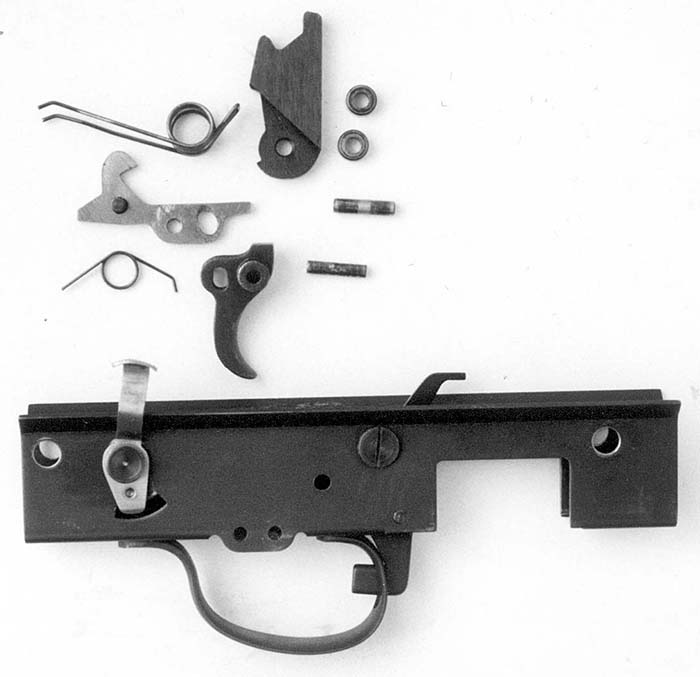
Interest on hi-tech long arms has long waned, due primarily to their prohibitive costs and strict government regulations that since banned many models that use to be accessible to private buyers. For those who followed the history of sub-gun market boom in the 80’s and the decade that followed after, the Bingham PPS-50 needs no introduction. This awesome looking rimfire clone was patterned after the legendary World War II Russian burp gun, the PPSh41 submachine gun. It was manufactured in Italy by Filli Pietta in a small town called Mandolossa. Although unheard of in the import circle, this firm had been around for decades producing excellent single and double-barrelled break-open hunting shotguns. Their products were mostly offered for the local market with limited numbers being exported to other parts of Europe. Although produced in Italy, the PPS-50 bears a strong American design heritage. This is no surprise since this awesome-looking rimfire clone is indeed designed in the USA and manufactured in Italy.
The PPS-50 is not the first to feature a drum magazine for a rimfire self-loader. The early Casull later to be known as the American 180 SMG was the first. However the magazine is mounted horizontally over the gun. The Filli Pietta version is inserted in conventional position – below the gun. The PPS-50 drum is a pure performer when it comes to reliability. This is the only magazine in its calibre and format that the author found to work flawlessly with any type of .22 long rifle ammo including the truncated type bullets that are known to jam even the much-touted Ruger 10/22. There were several 50-round magazines offered for the 10/22 during the heyday of the exotic gun era. This include the Sanford 50, the Mitchell “Teardrop” shape and the Ram-Line double-column “banana”-type magazine. From these variations of after market accessories, only the Ram-Line brand proved reliable enough to match the factory 10-round rotary magazine.
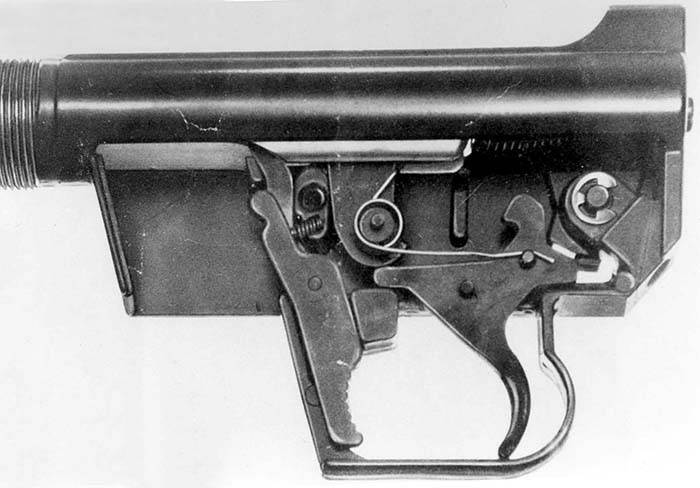
The PPS-50 drum magazine was very well made. It utilized all steel construction in its outer shell. It featured a unique follower arrangement in the form of three machined steel .22 LR dummies connected together by a rubber loop. The centrepiece of the drum-in-sprocket configuration is a circular disc made of hi-impact polymer. The sprocket allows the cartridges to be neatly stacked during loading. This component is powered by a clock-type spring similar to those used in the famous Thompson SMG drum. The tension of the spring is manually adjustable by the number of turns of the sprocket, which can be set to conform to the timing cycle of the bolt during operation. Most magazines suffer from spring fatigue after heavy usage or with the magazine left loaded after a long period of time. Not so with the PPS-50 drum. You can leave a fully loaded magazine for months and expect it to work when called upon. To facilitate easy loading with the drum, Filli Pietta came up with a simple loading device in the form of a bent wire that attaches to the left side of the magazine lips. Charging a full 50 rounds in the drum can be accomplished in just few minutes and is quite easy.
The overall fit and finish of the magazines supplied with the PPS-50 are excellent. The top end of the 30-shot version utilized a filler, which is made of alloy casting. The filler has the usual built-in feed ramp found on the drum. While both of these magazines performed flawlessly during my extensive testing, there is one flaw that I noted on the drum design that needed serious fixing. On one occasion, the rubber loop that connects the three cartridge shaped followers snapped while the gun was being fired. After the last round was fired, the top dummy round of the follower was chambered after being separated from the retaining loop. Unless you are counting the rounds being fired or the gun has a last round “hold-open” device, it is difficult to know if a dummy round has been loaded instead of a live one. In a real life-threatening situation, this could result in serious consequences. Furthermore, if you are using the gun in a bush or forest where tall grass covers the ground and eject the dummy round thinking it is a misfire, the chance of losing this very important part is very likely. This will render the drum unserviceable since the remaining two dummy rounds will just fall off from the magazine as soon as the drum is removed from the gun.
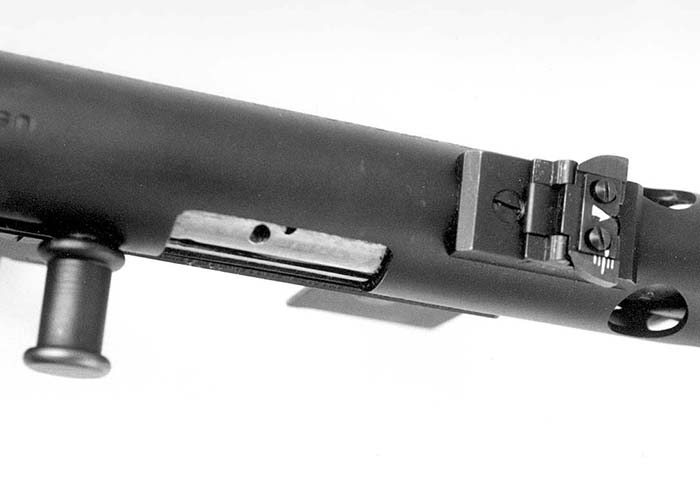
To correct this serious flaw, I have redesigned the follower arrangement but still retained the three dummy round principle as the follower. The fragile rubber band loop retainer was omitted. The rubber loop becomes brittle as it is exposed to oil when the magazine is lubricated. In its place, a coil spring is substituted to power the compression and decompression of the dummy round followers as they were forced to move upward by the sprocket to position the last round on top of the magazine. The new improved follower arrangement proved to function even better.
THE TRIGGER LOCKWORK Ultra-simple but seriously flawed.
The PPS-50’s trigger lockwork is very simple – at least that’s how it looks like when I first disassembled the gun for cleaning. When I examined the mechanism, the first thought that came into mind is the Armalite designed AR-7 Explorer carbine. The internal components of the PPS-50 and AR-7 are almost identical including the bolt design. In fact, you can use the PPS-50 bolt in the AR-7 but not vice versa. The hammer on the Italian made gun is thicker and will not pass through the opening at the back of the US made bolt. In addition, the PPS-50 incorporated a simple but highly efficient buffer system to soften the recoil in the form of a large coil spring, which supports the back plate of the recoil spring guide. Another excellent feature added to work in conjunction with the improved bolt assembly is the retarding effect of the bolt’s movement as it reaches the last stage of recoil. This is accomplish by incorporating an incline shoulder at the end of the cocking handle travel slot. As the bolt reaches the end of its cycle, the cocking handle is forced by the incline slot to slightly rotate, thereby creating a slight delay on its forward action which in turn allows the next round to seat itself properly into loading position before the bolt scoops it up towards the chamber. This unique bolt retarding effect can be attributed to the PPS-50’s outstanding loading reliability, which also proved highly workable in the Ruger 10/22 design.
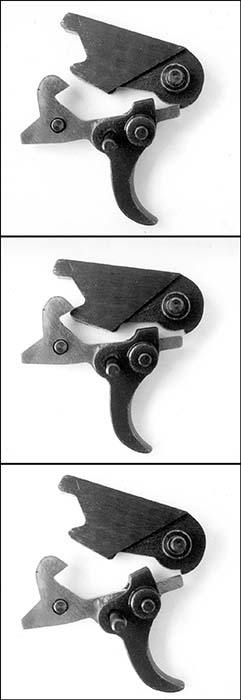
Top: Close-up view of the hammer cocked with the sear’s front end. In the AR-7, the front of the trigger acts as the primary sear. Center: Close-up view showing the hammer engaged with the secondary sear (rear hook of sear). The pull on the trigger pushes the rear of sear upward to engage the hammer on this position while being depressed by the bolt during recoil after a shot was fired. Bottom: View showing the hammer being let go by the secondary sear’s hook after the trigger pull is released. Normally, the primary sear (front of sear) would engage the cocking notch of the hammer in this sequence. The rocking motion along with the fore and aft movement of the sear allows the sear to move slightly backward resulted in the hammer missing the connection resulting in an accidental discharge (doubling).
In the 10/22, the retarding effect is accomplished using two-step bolt. The trigger housing had matching inclined shoulders to force the bolt to move downward as it follows the rear contour of the receiver. As the bolt reaches the end of its rearward cycle, its center step engages momentarily with incline shoulder of the trigger housing resulting in a slight delay. The retarding effect allows the 10-shot rotary magazine’s sprocket to position the next cartridge properly on the feed lips before the bolt pushes it towards the chamber. Now you can clearly see why the 10/22 worked so well. The makers of the PPS-50 certainly did their assignment here combining the best mechanical features of America’s best selling rimfire carbines namely the AR-7 and 10/22. For looks, the Russian PPSh41 SMG format completes the final touch. These are winning combinations that made the PPS-50 one of the best selling .22 look-alike imports in America.
Despite all the great attributes found on the PPS-50, it has yet another very serious flaw. The trigger lockwork of the gun owed much from the popular AR-7 carbine with minor differences. This includes a separate sear mounted on top of the trigger. The usual hammer spring arm that acts as a trigger return for the AR-7 only works with the internal sear. This new arrangement required a separate trigger spring, which is mounted on the left side of the trigger. The separate sear system employed in the Italian clone is basically aimed at improving the trigger pull as well as eliminating the usual trigger kick felt on the AR-7 while it is being fired. This is due to the absence of a separate disconnector system. In the PPS-50, the trigger-mounted sear does all the mechanical work with the hammer. The trigger is merely acting as a bridge for the sear. When I first tested the gun, it worked flawlessly, firing nearly 500 rounds until it started doubling, followed by misfires in between. I went through the usual drill of clearing, chambering etc., but the problem still persisted.
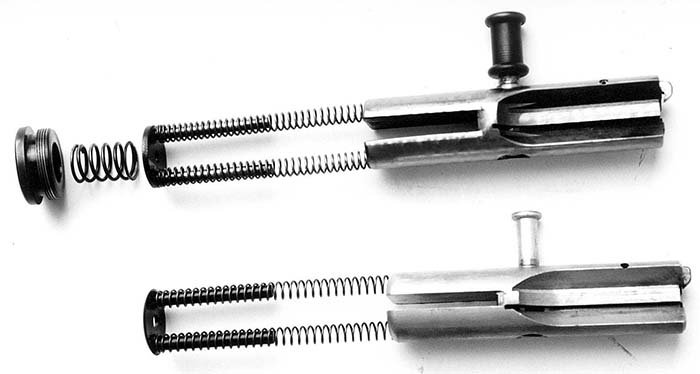
I packed my things up and drove home and went straight to my workbench. I stripped the gun completely and examined each part to determine what had caused the unexpected malfunctions that had no apparent cause. There were no visible damage or fault on the design that I could see. When I re-assembled all the parts back into the trigger housing and worked them manually, the components functioned just fine. I mated the trigger assembly back to the top end and operated the action manually. Again, everything seems to be working normally.
At the end of the day, I was able to trace the culprit that leads me to the conclusion that despite the simplicity of the trigger lockwork, the design itself is completely faulty. In the AR-7 design, there are only three moving parts namely: the trigger, hammer and bolt. In the PPS-50, this number was increased to four with the addition of the separate sear that pivots over the trigger in a seesaw motion. Both the sear and the trigger have an oblong slot to allow the rocking action of the sear during its connection and disconnection sequence with the hammer. The gun worked for a while but after a few hundred rounds were fired, it started doubling. After firing the first round, the bolt will recoil to re-cock the hammer with the secondary sear (rear hook) connecting with the upper step of the hammer. Releasing the pull on the trigger, automatically fires the next round. The hammer should have been intercepted by the front end of the sear and held it in the fully cocked position. In this case, the sear missed the hammer and fired accidentally. The third round was loaded after the unwanted second shot and the hammer followed the bolt in its forward closing resulting in a misfire. What happened? Firstly, the gun worked for a few hundred rounds but as soon as the tip of the top front-end corner of the sear (the only portion catching the hammer after the disconnection took place) wore out, the doubling occurred. Secondly, the oblong slots cut on both the sear and trigger to allow the rocking motion of the sear also permitted unnecessary fore and aft play. The gaps of the twin slots allowed the sear to unnecessarily move slightly backward as the cocking notch of the hammer tries to re-engage the sear during cocking motion. The actual misalignment of the hammer notch and the front-end portion of the sear that normally engages the hammer takes place immediately after the trigger pull is released and the hammer was let go by the secondary sear. In normal sequence, the hammer should be held cocked by the front end of the sear. However in this sequence, it was missed by the sear, thereby causing the gun to fire accidentally, as the trigger pull is released. The third round of course is a misfire since the normal disconnection process is no longer taking place.
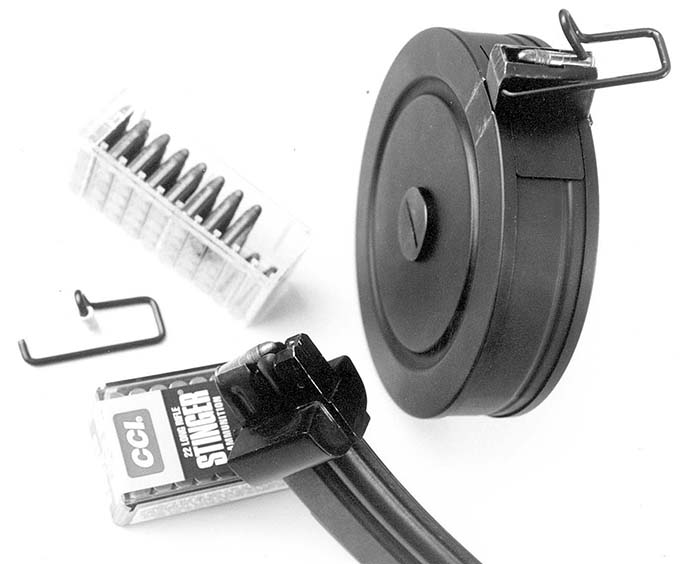
After having identified all the major design flaws of the gun, the next step is to come up with an alternative trigger lockwork that would provide a lighter and more consistent trigger pull. This remedy must be accomplished utilizing most of the original components to make the revision practical and economical. I made few sketches and finally came up with what I considered an ideal alternative to the original. I call the experimental mechanism the “Special Purpose Rifle” (SPR) system. It rivals the trigger pull of a tuned up 1911 pistol while retaining the overall mechanical simplicity of the PPS-50.
For those who owned this marvelous import and had experienced the same dilemma I had, the revised trigger mechanism could very well be the perfect cure for the PPS-50’s serious bug. Any qualified gunsmith can easily make this simple modification. The new lockwork provided far smoother and lighter trigger pull when compared to the original. In addition, the SPR mechanism gives the operator the advantage of faster and more accurate follow-up shots when needed, thanks to its ultra short trigger pull. Find out more about the SPR-50 modification in Part-two of this article in the next issue of SAR.
| This article first appeared in Small Arms Review V7N2 (November 2003) |










